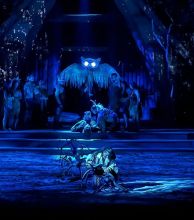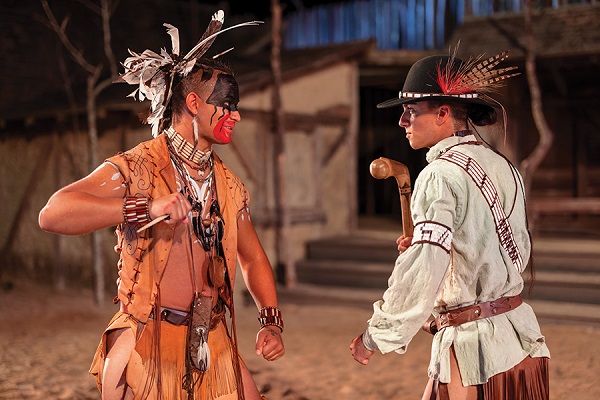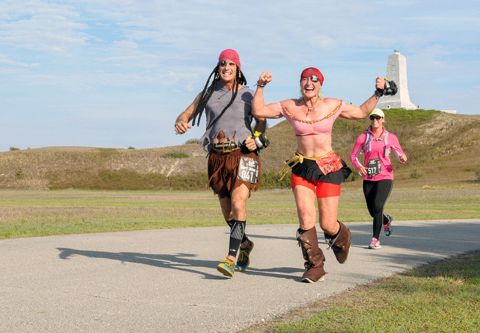
There’s been fanfare at The Lost Colony this week as First Lady of North Carolina Kristin Cooper visited and even made cameo appearances in the show. She performed as a maiden to Queen Elizabeth I in the August 1 and 2 performances.
“It is such an honor to be included,” Cooper says. “The cast and crew are phenomenal, and I encourage everyone to see this historic play. Truly, this production is a North Carolina treasure.”
While the guest appearance was exciting (as will be the guest appearances by live babies in the show on Virginia Dare’s birthday, August 18), the most exciting thing about The Lost Colony right now is the show itself. If you have never seen the show, or if it has been a while since you have seen it, I’m telling you — you need to go! With major upgrades in lighting, special effects, choreography, Kabuki shadow play and puppetry, the show is more of a visual spectacle than ever. And with the incorporation of a more Native American perspective, the show is more thought-provoking and authentic than ever.
The Lost Colony has always been a great play depicting the fascinating historic story of the 1587 English colony on Roanoke Island, as imagined by playwright Paul Green. It has been a beloved tradition on Roanoke Island for 86 years. There is no doubt that the outdoor drama would not have survived almost nine decades if it was not a wonderful story and production.
Like all traditions, the outdoor drama has naturally evolved over the years. It has always been true to Green’s original script, but over the last 86 years the telling of the story has progressed and changed in incremental ways. Every generation and different director has added new elements, some subtle, some much more obvious, to the narrative and brought in modern technologies to portray the story in a fresh way that suits the current times. This means that the show we see today is a far cry from the original 1937 production.

Photo: North Carolina First Lady Kristen Cooper (right) performing in The Lost Colony on August 1. Photo by Cindy McEnery Photography
Everything from the set and lighting to the narrator, costumes, music and dancing has changed over and over again. And that’s part of what makes the show so fun to see. We all know the story, but how we are entertained in the telling is the fun part.
The Lost Colony under director and choreographer Jeff Whiting is by far the most progressive and innovative production of the outdoor drama to date. Whiting, who came to The Lost Colony in 2021, has a long and distinguished list of Broadway, Disney, opera, television, concert and special event credits. He brought in new creative talent as well, and their collective experience, expertise and modern technical advances bring the traditional show to a whole new level – something you would expect to see in a big-city setting, not on a tiny North Carolina island. In fact, they employ techniques that have become standard on Broadway but had yet to make it to Roanoke Island.
I saw The Lost Colony this week and was amazed! It's fresh and spectacular, and here are the top five reasons I loved it.
The Natives’ Perspective
One of the most important changes to The Lost Colony has been the move to incorporate the Native American perspective rather than tell it from a singularly European viewpoint. In 2021 Whiting and Roanoke Island Historical Association, which produces the show, sought the counsel of North Carolina’s Lumbee Tribe for help in being more respectful of the Native American perspective, culture and faith. The show now incorporates the Native American viewpoint of the English colonists’ arrival in a much more vital way. The narrator, traditionally a male representing the English perspective, has been changed to a female Native American storyteller. Additionally, The Lost Colony’s Native American roles are now portrayed by Native American actors, and there is more authenticity in the Native American dancing, costumes and cultural representations.

3D Mapping
Employing 3D mapping, which is basically superimposing moving images onto the set, creates imaginative and highly memorable dramatic scenes. The 3D-mapped projections magically transport the audience from Roanoke Island's Waterside Theatre to the English garden of Queen Elizabeth I, to a stormy sea in the ocean or to the deep woods of Roanoke Island. The Lost Colony’s 3D projection designer, Christopher Ash, played a prominent role in the Broadway show New York, New York, which is currently nominated for a Tony in Best Scenic Design. As a bonus: the show's lighting design is also spectacular!
Puppetry
The Lost Colony now uses puppetry to great effect. A giant owl puppet, which serves as a Native American omen of death, makes several dramatic appearances. Some of the play’s violence is depicted in a theatrical way, as a parable, with elk, bear and wolf puppets. Whiting hired New York designer Nicholas Mahon to create theatrical puppets that begin the play resembling trees in the scenery and then magically transform to become bears, elk and wolves that represent the fighting between the Natives and colonists. The actors shift to the puppets, and the result is striking.
A New Score
The Lost Colony is known as a symphonic drama but previously lacked a full score. Whiting hired composer Sam Davis, who is currently nominated for a Tony award, to write a symphonic score that provides an added auditory element to the play. The score features not only traditional songs and old English tunes, but also a composition that symphonically underscores the action of the play. The Lost Colony recently received a grant to purchase the sound system used to broadcast Davis’ score throughout the theater.
Pre-Show Entertainment
Adding to the enhanced Native American perspective is the addition of a Pre-Show Native American Cultural Presentation. Before the show there is a Native American dance demonstration and explanation of what the dances mean. This serves as an early reminder that the rich culture of the Native Americans was well established long before the English colonists arrived on Roanoke Island and invaded the native lands. And that the rich culture continues today. The Pre-Show entertainment is held on Tuesday, Fridays and Saturdays at 8 p.m.

Photo: The soundfront, tree-lined setting at Waterside Theatre on Roanoke Island is truly spectacular.
Whiting and his talented team of theater professionals have managed to bring an undeniable touch of Broadway flair and excitement to this historic production. You’ll experience the Tony Award-winning show you know and love in a whole new way.
“I think one thing that’s important to note is that although we’ve reimagined the show, we haven’t changed the plot or the show itself,” Whiting says. “It was very important for us to honor the original show. The reinvention has been primarily in modernizing the staging, the visual aspect and the music.”
There’s much more to love about The Lost Colony than the five things listed above, of course, including a phenomenal cast, gorgeous costumes, new seats with cupholders, beer and wine for sale, concessions, the beautiful Waterside Theatre setting and more. Be sure to go before the season ends on August 26.
Want to go?
86th Season of The Lost Colony
June 2 to August 26
Monday through Saturday 8:30 p.m.
Tickets: $25 to $40
Pre-Show Native American Cultural Presentations: Tuesdays, Fridays and Saturdays at 8 p.m. (included in ticket price)
Backstage Tours: Nightly 7:30 p.m. (additional cost, $15)
For tickets and more information, go to thelostcolony.org or call (252) 473-6000
The Lost Colony is sponsored by PNC Bank.


 Molly Harrison is managing editor at OneBoat, publisher of OuterBanksThisWeek.com. She moved to Nags Head in 1994 and since then has made her living writing articles and creating publications about the people, places and culture of the Outer Banks.
Molly Harrison is managing editor at OneBoat, publisher of OuterBanksThisWeek.com. She moved to Nags Head in 1994 and since then has made her living writing articles and creating publications about the people, places and culture of the Outer Banks.

